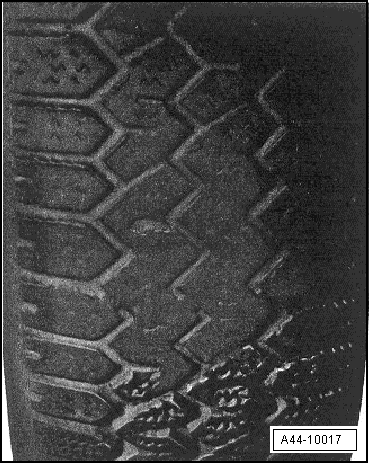Volkswagen Tiguan Service and Repair Manual: Driving Noise
Tires, Rolling Noises, General Information
Rolling noise perceived by the human ear is caused by vibrations transmitted from the noise source to the ear via the air.Here we are interested in noises created by certain characteristics of the tires as well as the effects of rolling (noise source).
The cause for the noise generation depends primarily on the combination of road surface and tire.The surface structure and material of the road surface also have a strong influence on the rolling noise. For example, the noise level on a wet road is substantially higher than on a dry road.
The design of the tread has a great influence on the noise generation. Tires with cross grooves at an angle of 90º are louder than tires with grooves running diagonally.Small tread blocks are unstable. Due to strong deformation, the air is excited by the rolling tires. Air vibrations occur, which will generate noises.
Wider tires are louder. They require more tread grooves for water displacement. Air is displaced by these tread grooves while rolling, which also cause air vibrations.Other effects which also have an influence on noise generation:
- "Tire vibration" is the main cause of rolling noise. The noise is generated by the excitation of the air column in the grooves.
- "Air pumping" is the compression and expansion of air as the contact patch comes in contact with the road surface and the tread blocks are deformed.
Noise generation is created chiefly by tires and the road surface.
Influencing factors of road surface are roughness, structure and material.Influencing factors for tires fall under different tire and rim widths. A wider tire generates more noise due to its wider contact patch than a narrower tire does, because more air is displaced and a greater "mass" is caused to vibrate.
A wider rim also causes the tire to have a wider contact patch. The effects on noise generation are basically the same as those of a wider tire. In addition, the noise suppression characteristics of the tire can, under certain circumstances, be negatively affected by the wider rim.The tire rolling noise is significantly noticeable in the rear of vehicles with front engines, because wind and engine noise are less audible in the back.
Wear Spots
Wear spots are caused by a hard stop with locked wheels whereby the rubber compound is abraded from the contact patch.When the tires slide across the road surface, frictional heat is generated which reduces the abrasion resistance on the tread compound.
Even the most abrasion-resistant tread compound cannot prevent wear spots which can occur during extreme braking.Even ABS cannot completely prevent brief locking and the resulting slightly flat spots.
The degree of abrasion is primarily dependent on the vehicle speed, road surface and tire load. For clarification see the following examples.If a vehicle with locked front wheels is decelerated until it comes to a stop, the abrasion of rubber on the post card sized contact patch is approximately
- from 57 km/h (35.41 mph) = 23.8 m braking distance, up to 2.0 mm,
- from 75 km/h (46.60 mph) = 41.8 m braking distance, up to 3.3 mm,
- from 92 km/h (57.16 mph) = 71.6 m braking distance, up to 4.8 mm.
Wear Spots in Tread
Tires with this type of damage cannot be used and must be replaced.

 Vehicle Pulls to One Side
Vehicle Pulls to One Side
General Information
Perform a road test to determine if a vehicle pulls to one side and if so,
when and to which side. If the vehicle pulls to one side.
If the vehicle alignment is measured, submit t ...
See More:
Volkswagen Tiguan Owners Manual > Power sunroof: Power sunroof – convenience closing feature
Read and follow the introductory information and
safety information first⇒Introduction
to the subject Convenience closing
The convenience closing feature lets you close the power sunroof as follows:
Turn the vehicle key bit in the lock of the driver door to the closing position
and h ...
Volkswagen Tiguan Owners Manual
Volkswagen Tiguan Service and Repair Manual
- Body exterior
- Body Interior
- General Paint Information
- Paint
- Brake System
- Suspension, Wheels, Steering
- Wheel and Tire Guide
- Towing Guide
- Wheel and Tire Guide General Information
- Communication
- Electrical Equipment General Information
- Electrical Equipment from 06/2011
- Heating, Ventilation and Air Conditioning
- Refrigerant R134a Servicing
- 6-Speed Manual Transmission 02Q, OBB, and OFB

